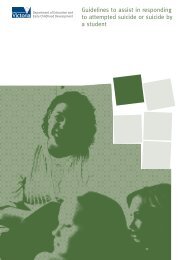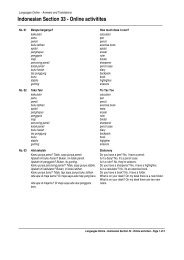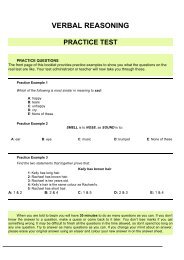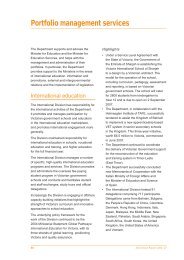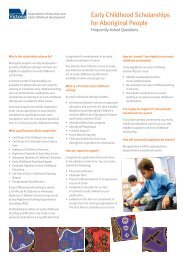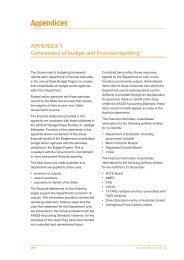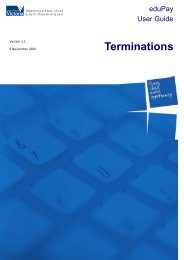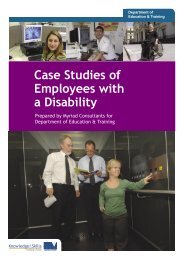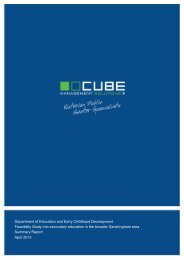November 2009 Vol. 1, Issue 10 (PDF - 16.2Mb) - Department of ...
November 2009 Vol. 1, Issue 10 (PDF - 16.2Mb) - Department of ...
November 2009 Vol. 1, Issue 10 (PDF - 16.2Mb) - Department of ...
Create successful ePaper yourself
Turn your PDF publications into a flip-book with our unique Google optimized e-Paper software.
54 Nov 09 Research Xxxx<br />
Q&A with Pr<strong>of</strong>essor<br />
Mike Bullis<br />
Mike Bullis, from the University <strong>of</strong> Oregon in the United States, is a world-renowned expert on<br />
secondary education for children with special needs. He talks with Shine about how curriculum<br />
needs to be structured to ensure young people with disabilities have maximum opportunity for<br />
employment in the future.<br />
Why do students with disabilities need a special<br />
program in the last years <strong>of</strong> schooling?<br />
Adolescents with disabilities experience difficulties after leaving school and<br />
when trying to enter adult roles in the community. Transition experiences<br />
are especially poor for ‘high incidence’ disability categories such as specific<br />
learning disabilities and young people with emotional or behavioural<br />
disabilities (EBD). Given the generally poor post-school outcomes for<br />
adolescents with disabilities, and the US federal legislation that calls for<br />
the purpose <strong>of</strong> public education to be to prepare students with disabilities<br />
to enter society as successful citizens, the high school years are likely to be<br />
the last opportunity for a concerted effort to prepare these young people for<br />
adult roles in society. There is absolutely no question that such an emphasis<br />
is critical to the ultimate wellbeing <strong>of</strong> the young people we have pledged to<br />
teach and serve.<br />
What evidence is there to back up your view?<br />
According to research conducted over 20 years in the United States,<br />
including numerous surveys, most adolescents with disabilities experience<br />
significant challenges after leaving the school system. Many have problems<br />
accessing social services, enrolling in and completing post-secondary<br />
education, and entering a meaningful and well-paid career path. In recent<br />
years there has been an increase in adolescents with disabilities enrolling in<br />
post-secondary education, but that percentage is still far lower than those<br />
without disabilities.<br />
National and state-level studies in the US show that around 40 per cent <strong>of</strong><br />
adolescents with EBD drop out <strong>of</strong> school. In the first few years after school,<br />
less than a quarter receive services from community-based social service<br />
agencies, only 15 per cent enrol in post-secondary education, and just<br />
more than half secure a competitive job. Data for adolescents with specific<br />
learning disabilities are generally a bit better, but still low compared to peers<br />
without disabilities.<br />
What is an ideal curriculum structure for these<br />
students at this stage <strong>of</strong> their schooling?<br />
I believe that the best curriculum for adolescents with disabilities in high<br />
school is one with a focus on the community setting and each student’s<br />
transition from school and into adult roles. By this I mean that for roughly<br />
<strong>10</strong>–15 hours per school week, students should have numerous and regular<br />
opportunities to explore different career options by shadowing workers in<br />
careers <strong>of</strong> potential interest, visiting possible post-secondary programs, and/<br />
or having opportunities for both paid and unpaid work experiences.<br />
There is a correlation between young people having successful work<br />
experiences while in school and working successfully after leaving. It is<br />
critical that these placements are developed carefully and supported by<br />
educators who will work in both community and school settings. Academic<br />
classes should be based on the demands <strong>of</strong> the work or educational setting<br />
in which the student either is, or most likely, to be placed. This ‘contextual



